climate control KIA Forte 2013 2.G User Guide
[x] Cancel search | Manufacturer: KIA, Model Year: 2013, Model line: Forte, Model: KIA Forte 2013 2.GPages: 353, PDF Size: 7.3 MB
Page 157 of 353
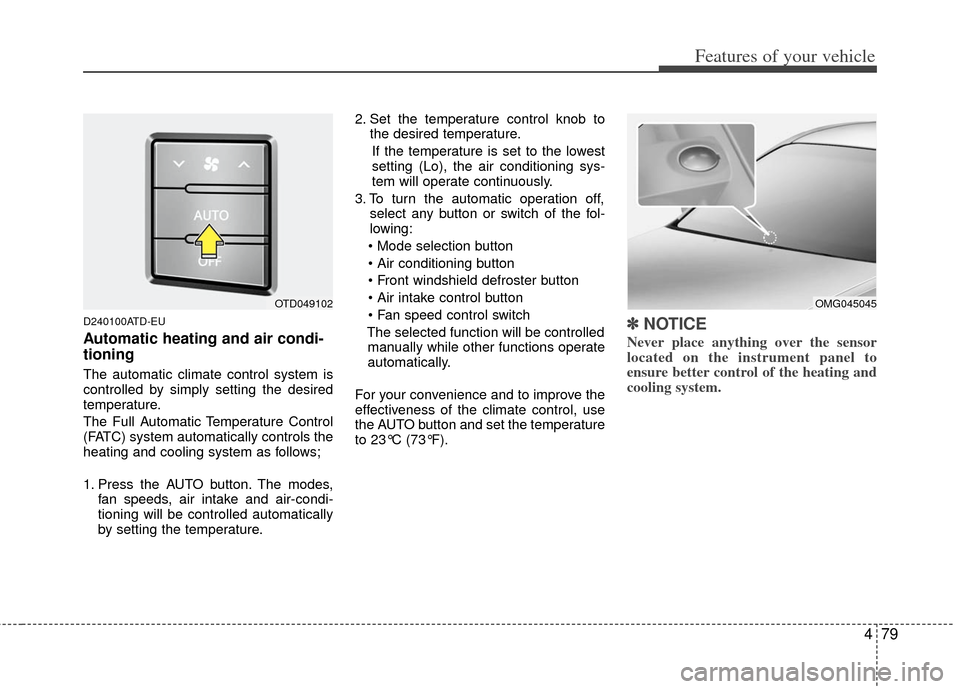
479
Features of your vehicle
D240100ATD-EU
Automatic heating and air condi-
tioning
The automatic climate control system is
controlled by simply setting the desired
temperature.
The Full Automatic Temperature Control
(FATC) system automatically controls the
heating and cooling system as follows;
1. Press the AUTO button. The modes,fan speeds, air intake and air-condi-
tioning will be controlled automatically
by setting the temperature. 2. Set the temperature control knob to
the desired temperature.
If the temperature is set to the lowest
setting (Lo), the air conditioning sys-
tem will operate continuously.
3. To turn the automatic operation off, select any button or switch of the fol-
lowing:
The selected function will be controlled manually while other functions operate
automatically.
For your convenience and to improve the
effectiveness of the climate control, use
the AUTO button and set the temperature
to 23В°C (73В°F).
вњЅ вњЅ NOTICE
Never place anything over the sensor
located on the instrument panel to
ensure better control of the heating and
cooling system.
OMG045045OTD049102
Page 161 of 353
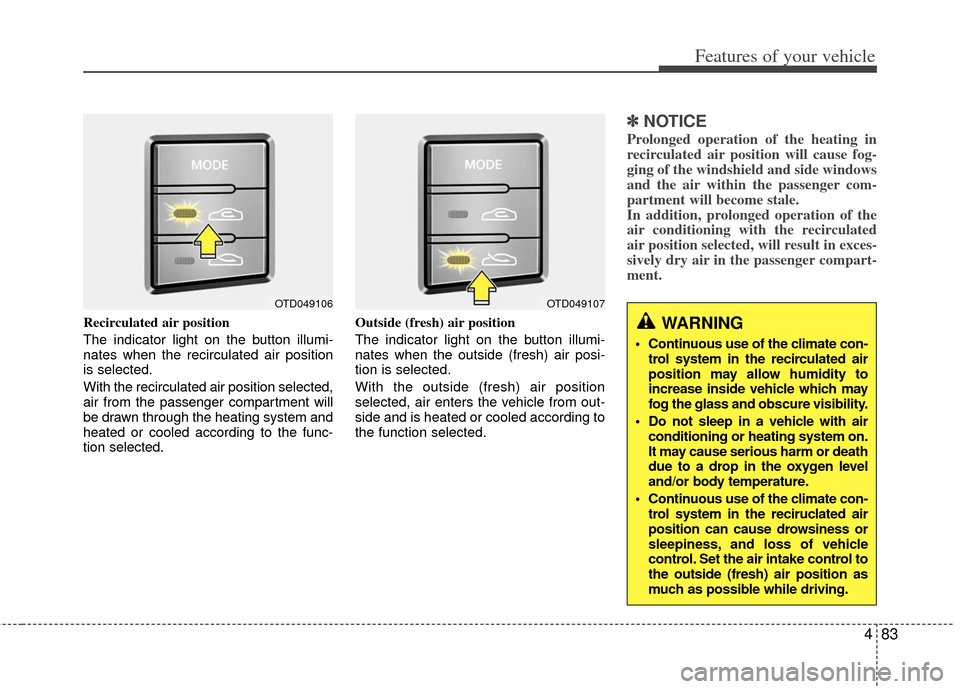
483
Features of your vehicle
Recirculated air position
The indicator light on the button illumi-
nates when the recirculated air position
is selected.
With the recirculated air position selected,
air from the passenger compartment will
be drawn through the heating system and
heated or cooled according to the func-
tion selected.Outside (fresh) air position
The indicator light on the button illumi-
nates when the outside (fresh) air posi-
tion is selected.
With the outside (fresh) air position
selected, air enters the vehicle from out-
side and is heated or cooled according to
the function selected.
вњЅ вњЅ
NOTICE
Prolonged operation of the heating in
recirculated air position will cause fog-
ging of the windshield and side windows
and the air within the passenger com-
partment will become stale.
In addition, prolonged operation of the
air conditioning with the recirculated
air position selected, will result in exces-
sively dry air in the passenger compart-
ment.
WARNING
Continuous use of the climate con-
trol system in the recirculated air
position may allow humidity to
increase inside vehicle which may
fog the glass and obscure visibility.
Do not sleep in a vehicle with air conditioning or heating system on.
It may cause serious harm or death
due to a drop in the oxygen level
and/or body temperature.
Continuous use of the climate con- trol system in the reciruclated air
position can cause drowsiness or
sleepiness, and loss of vehicle
control. Set the air intake control to
the outside (fresh) air position as
much as possible while driving.
OTD049106OTD049107
Page 162 of 353
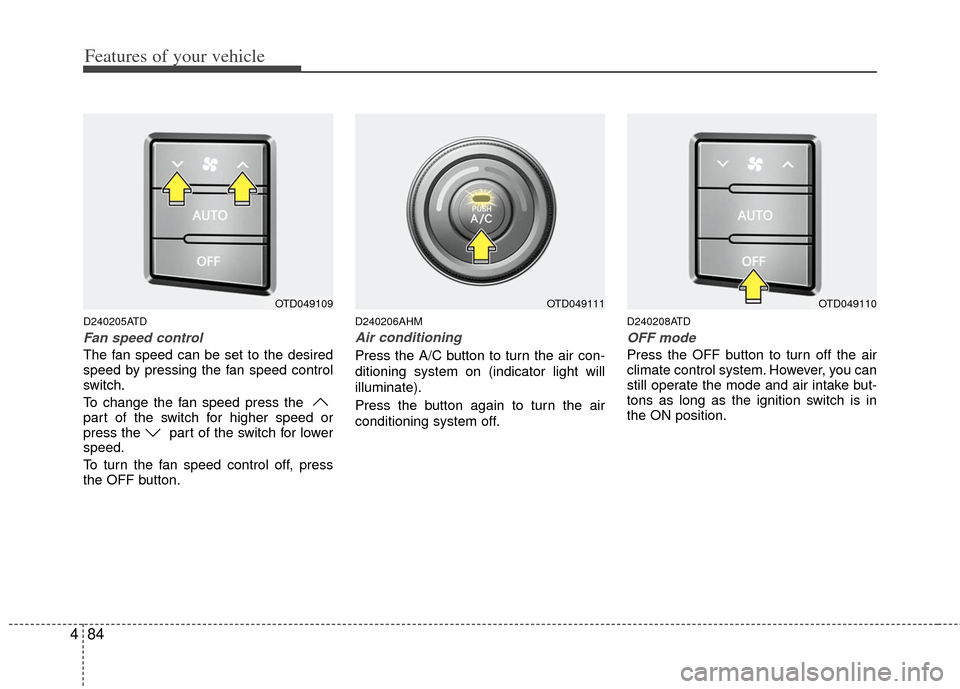
Features of your vehicle
84
4
D240205ATD
Fan speed control
The fan speed can be set to the desired
speed by pressing the fan speed control
switch.
To change the fan speed press the
part of the switch for higher speed or
press the part of the switch for lower
speed.
To turn the fan speed control off, press
the OFF button.
D240206AHM
Air conditioning
Press the A/C button to turn the air con-
ditioning system on (indicator light will
illuminate).
Press the button again to turn the air
conditioning system off.
D240208ATD
OFF mode
Press the OFF button to turn off the air
climate control system. However, you can
still operate the mode and air intake but-
tons as long as the ignition switch is in
the ON position.
OTD049109OTD049111OTD049110
Page 163 of 353

485
Features of your vehicle
WINDSHIELD DEFROSTING AND DEFOGGING
D250000AUN For maximum defrosting, set the tem-perature control to the extreme
right/hot position and the fan speed
control to the highest speed.
If warm air to the floor is desired while defrosting or defogging, set the mode
to the floor-defrost position.
Before driving, clear all snow and ice from the windshield, rear window, out-
side rear view mirrors, and all side win-
dows.
Clear all snow and ice from the hood and air inlet in the cowl grill to improve
heater and defroster efficiency and to
reduce the probability of fogging up
the inside of the windshield.
Manual climate control system
D250101AFD
To defog inside windshield
1. Select any fan speed except “0” posi- tion.
2. Select desired temperature.
3. Select the or position.
4. The outside (fresh) air will be selected automatically.
If the outside (fresh) air position is not
selected automatically, press the corre-
sponding button manually.
OTD049112N
WARNING - Windshield heating
Do not use the or position
during cooling operation in
extremely humid weather. The dif-
ference between the temperature of
the outside air and the windshield
could cause the outer surface of
the windshield to fog up, causing
loss of visibility. In this case, set
the mode selection knob or button
to the position and fan speed
control knob or button to a lower
speed.
Page 164 of 353

Features of your vehicle
86
4
D250102AFD
To defrost outside windshield
1. Set the fan speed to the highest
(extreme right) position.
2. Set the temperature to the extreme hot position.
3. Select the position.
4. The outside (fresh) air will be selected automatically.
Automatic climate control system
D250201ATD
To defog inside windshield
1. Select desired fan speed.
2. Select desired temperature.
3. Press the defroster button ( ).
4. The outside (fresh) air position will beselected automatically.
If the outside (fresh) air position is not
selected automatically, adjust the corre-
sponding button manually.
D250202ATD
To defrost outside windshield
1. Set the fan speed to the highest posi- tion.
2. Set the temperature to the extreme hot (HI) position.
3. Press the defroster button ( ).
4. The outside (fresh) air position will be selected automatically.
OTD049114NOTD049115NOTD049113N
Page 165 of 353

487
Features of your vehicle
D250300AHM
Defogging logic
To reduce the probability of fogging up
inside of the windshield, the air intake or
air conditioning are controlled automati-
cally according to certain conditions such
as or position. To cancel or
return to the defogging logic, do the fol-
lowings.
D250301AUN
Manual climate control system
1. Turn the ignition switch to the ON posi-tion.
2. Turn the mode selection knob to the defrost position ( ).
3. Push the air intake control button at least 5 times within 3 seconds.
The indicator light in the air intake control
button will blink 3 times with 0.5 second
of interval. It indicates that the defogging
logic is canceled or returned to the pro-
grammed status.
If the battery has been discharged or dis-
connected, it resets to the defog logic
status.
D250302AHM-EE
Automatic climate control system
1. Turn the ignition switch to the ON posi- tion.
2. Select the defroster position pressing the defroster button ( ).
3. While pressing the air conditioning button (A/C), press the air intake con-
trol button ( ) at least 5 times with-
in 3 seconds.
The A/C display blinks 3 times with 0.5
second of interval. It indicates that the
defogging logic is canceled or returned to
the programmed status.
If the battery has been discharged or dis-
connected, it resets to the defog logic
status.
Page 280 of 353

7
Engine compartment / 7-2
Maintenance services / 7-3
Owner maintenance / 7-4
Maintenance schedule / 7-6
Explanation of scheduled maintenance items / 7-21
Engine oil / 7-24
Engine coolant / 7-25
Brake/clutch fluid / 7-28
Power steering fluid / 7-29
Automatic transaxle fluid / 7-30
Washer fluid / 7-30
Parking brake / 7-31
Air cleaner / 7-31
Climate control air filter / 7-32
Wiper blades / 7-32
Battery / 7-34
Tires and wheels / 7-37
Fuses / 7-50
Appearance care / 7-59
Emission control system / 7-65
Maintenance
Page 286 of 353
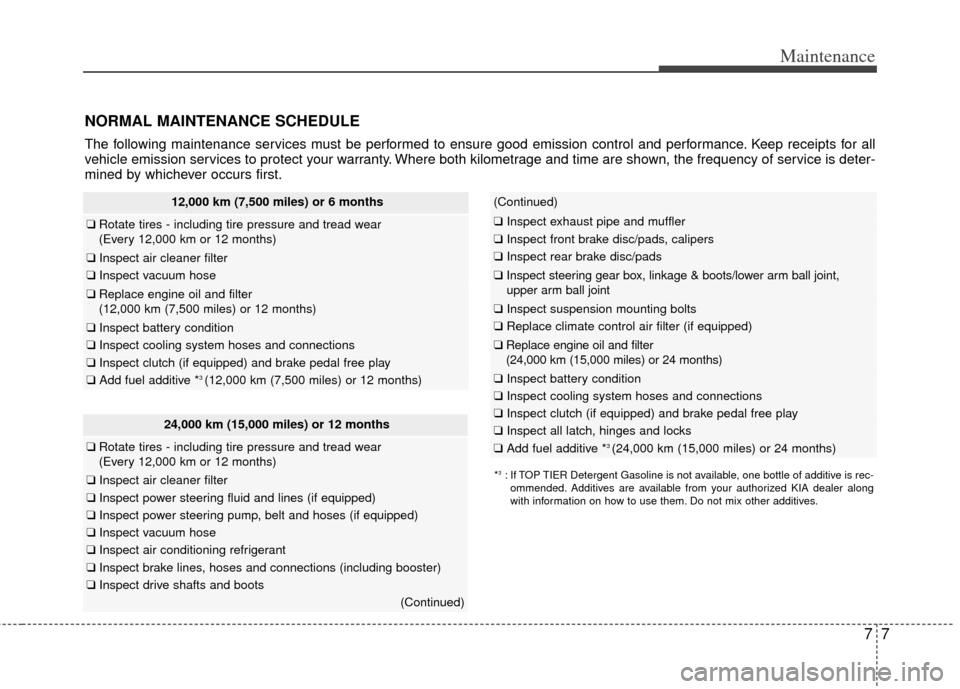
77
Maintenance
NORMAL MAINTENANCE SCHEDULE
The following maintenance services must be performed to ensure good emission control and performance. Keep receipts for all
vehicle emission services to protect your warranty. Where both kilometrage and time are shown, the frequency of service is deter-
mined by whichever occurs first.
24,000 km (15,000 miles) or 12 months
вќ‘Rotate tires - including tire pressure and tread wear
(Every 12,000 km or 12 months)
вќ‘ Inspect air cleaner filter
вќ‘Inspect power steering fluid and lines (if equipped)
вќ‘Inspect power steering pump, belt and hoses (if equipped)
вќ‘ Inspect vacuum hose
вќ‘Inspect air conditioning refrigerant
вќ‘Inspect brake lines, hoses and connections (including booster)
вќ‘Inspect drive shafts and boots
(Continued)
(Continued)
вќ‘Inspect exhaust pipe and muffler
вќ‘Inspect front brake disc/pads, calipers
вќ‘Inspect rear brake disc/pads
вќ‘Inspect steering gear box, linkage & boots/lower arm ball joint,
upper arm ball joint
вќ‘ Inspect suspension mounting bolts
вќ‘Replace climate control air filter (if equipped)
вќ‘Replace engine oil and filter
(24,000 km (15,000 miles) or 24 months)
вќ‘ Inspect battery condition
вќ‘Inspect cooling system hoses and connections
вќ‘Inspect clutch (if equipped) and brake pedal free play
вќ‘Inspect all latch, hinges and locks
вќ‘Add fuel additive *3 (24,000 km (15,000 miles) or 24 months)
12,000 km (7,500 miles) or 6 months
вќ‘Rotate tires - including tire pressure and tread wear
(Every 12,000 km or 12 months)
вќ‘ Inspect air cleaner filter
вќ‘Inspect vacuum hose
вќ‘Replace engine oil and filter
(12,000 km (7,500 miles) or 12 months)
вќ‘ Inspect battery condition
вќ‘Inspect cooling system hoses and connections
вќ‘Inspect clutch (if equipped) and brake pedal free play
вќ‘Add fuel additive *3 (12,000 km (7,500 miles) or 12 months)
*3: If TOP TIER Detergent Gasoline is not available, one bottle of additive is rec-
ommended. Additives are available from your authorized KIA dealer along
with information on how to use them. Do not mix other additives.
Page 287 of 353
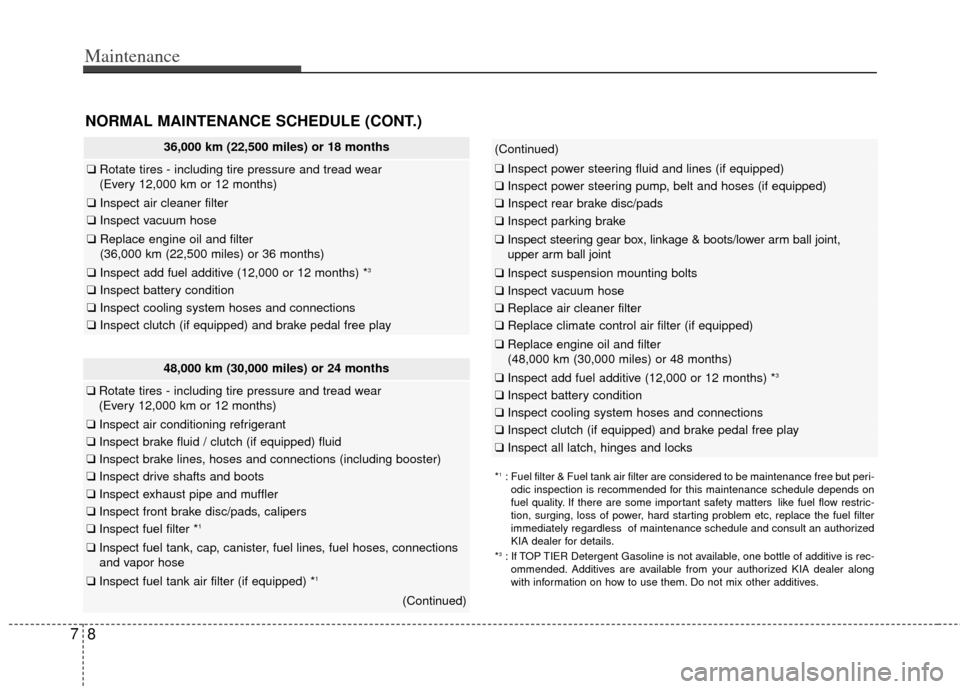
Maintenance
87
36,000 km (22,500 miles) or 18 months
вќ‘Rotate tires - including tire pressure and tread wear
(Every 12,000 km or 12 months)
вќ‘ Inspect air cleaner filter
вќ‘Inspect vacuum hose
вќ‘Replace engine oil and filter
(36,000 km (22,500 miles) or 36 months)
вќ‘ Inspect add fuel additive (12,000 or 12 months) *3
вќ‘Inspect battery condition
вќ‘Inspect cooling system hoses and connections
вќ‘Inspect clutch (if equipped) and brake pedal free play
NORMAL MAINTENANCE SCHEDULE (CONT.)
48,000 km (30,000 miles) or 24 months
вќ‘Rotate tires - including tire pressure and tread wear
(Every 12,000 km or 12 months)
вќ‘ Inspect air conditioning refrigerant
вќ‘Inspect brake fluid / clutch (if equipped) fluid
вќ‘ Inspect brake lines, hoses and connections (including booster)
вќ‘Inspect drive shafts and boots
вќ‘Inspect exhaust pipe and muffler
вќ‘Inspect front brake disc/pads, calipers
вќ‘Inspect fuel filter *1
вќ‘Inspect fuel tank, cap, canister, fuel lines, fuel hoses, connections
and vapor hose
вќ‘Inspect fuel tank air filter (if equipped) *1
(Continued)
(Continued)
вќ‘Inspect power steering fluid and lines (if equipped)
вќ‘Inspect power steering pump, belt and hoses (if equipped)
вќ‘ Inspect rear brake disc/pads
вќ‘Inspect parking brake
вќ‘Inspect steering gear box, linkage & boots/lower arm ball joint,
upper arm ball joint
вќ‘Inspect suspension mounting bolts
вќ‘ Inspect vacuum hose
вќ‘Replace air cleaner filter
вќ‘ Replace climate control air filter (if equipped)
вќ‘Replace engine oil and filter
(48,000 km (30,000 miles) or 48 months)
вќ‘ Inspect add fuel additive (12,000 or 12 months) *3
вќ‘Inspect battery condition
вќ‘Inspect cooling system hoses and connections
вќ‘Inspect clutch (if equipped) and brake pedal free play
вќ‘Inspect all latch, hinges and locks
*1: Fuel filter & Fuel tank air filter are considered to be maintenance free\
but peri-
odic inspection is recommended for this maintenance schedule depends on
fuel quality. If there are some important safety matters like fuel flow restric-
tion, surging, loss of power, hard starting problem etc, replace the fuel filter
immediately regardless of maintenance schedule and consult an authorized
KIA dealer for details.
*
3: If TOP TIER Detergent Gasoline is not available, one bottle of additive is rec- ommended. Additives are available from your authorized KIA dealer along
with information on how to use them. Do not mix other additives.
Page 288 of 353
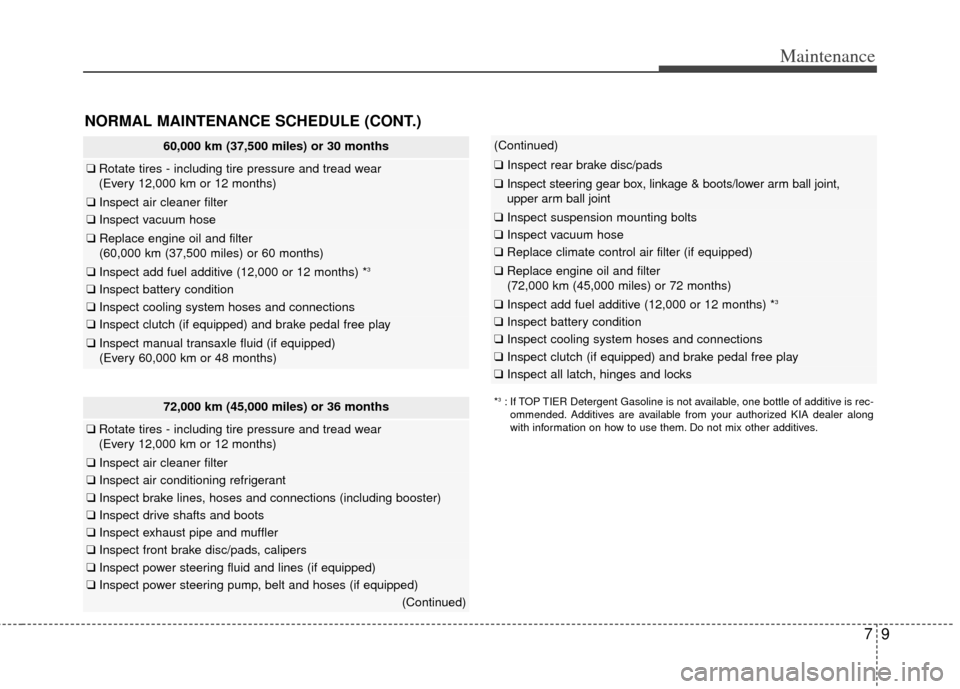
79
Maintenance
(Continued)
вќ‘Inspect rear brake disc/pads
вќ‘Inspect steering gear box, linkage & boots/lower arm ball joint,
upper arm ball joint
вќ‘ Inspect suspension mounting bolts
вќ‘Inspect vacuum hose
вќ‘Replace climate control air filter (if equipped)
вќ‘Replace engine oil and filter
(72,000 km (45,000 miles) or 72 months)
вќ‘ Inspect add fuel additive (12,000 or 12 months) *3
вќ‘Inspect battery condition
вќ‘Inspect cooling system hoses and connections
вќ‘Inspect clutch (if equipped) and brake pedal free play
вќ‘Inspect all latch, hinges and locks
72,000 km (45,000 miles) or 36 months
вќ‘Rotate tires - including tire pressure and tread wear
(Every 12,000 km or 12 months)
вќ‘ Inspect air cleaner filter
вќ‘Inspect air conditioning refrigerant
вќ‘Inspect brake lines, hoses and connections (including booster)
вќ‘Inspect drive shafts and boots
вќ‘Inspect exhaust pipe and muffler
вќ‘Inspect front brake disc/pads, calipers
вќ‘Inspect power steering fluid and lines (if equipped)
вќ‘Inspect power steering pump, belt and hoses (if equipped)
(Continued)
NORMAL MAINTENANCE SCHEDULE (CONT.)
60,000 km (37,500 miles) or 30 months
вќ‘Rotate tires - including tire pressure and tread wear
(Every 12,000 km or 12 months)
вќ‘ Inspect air cleaner filter
вќ‘Inspect vacuum hose
вќ‘Replace engine oil and filter
(60,000 km (37,500 miles) or 60 months)
вќ‘ Inspect add fuel additive (12,000 or 12 months) *3
вќ‘Inspect battery condition
вќ‘Inspect cooling system hoses and connections
вќ‘Inspect clutch (if equipped) and brake pedal free play
вќ‘Inspect manual transaxle fluid (if equipped)
(Every 60,000 km or 48 months)
*3: If TOP TIER Detergent Gasoline is not available, one bottle of additive is rec-
ommended. Additives are available from your authorized KIA dealer along
with information on how to use them. Do not mix other additives.